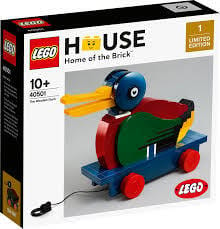Sponsored by
Turn PR wins into revenue wins
Are you still measuring PR success by clip counts and mentions?
HubSpot Media's free PR Value Calculator helps marketing professionals transform public relations from a cost center to a revenue generator.
With this powerful tool, you can:
Track actual engagement metrics that matter to your bottom line
Measure conversions directly attributable to PR activities
Calculate the real revenue impact of your PR campaigns
Demonstrate concrete ROI to executives and stakeholders
Get the calculator—free when you subscribe to the Masters in Marketing newsletter.
Join thousands of marketers getting smart, actionable insights from HubSpot Media’s top editorial team every week.
The Lion’s Den
🧩 The Story Of LEGO
When I hear someone say ‘LEGO’, I think of 3 things:
The awesome LEGO Hogwarts replica that I built in 3rd grade
The excruciating pain of stepping on one barefoot
Wooden ducks
Why wooden ducks?
Because when LEGO started on a small Denmark farm in 1932, LEGO was a wooden duck toy company…

Lego’s OG Wooden Duck
In the 92 years since then, LEGO has replaced wooden ducks with plastic bricks and has become a household staple.
Today, LEGO is known as ‘the conqueror of the toy industry’ - arguably one of the most competitive markets on the planet.
This is how a small duck company transformed into a $7 billion empire by leveraging the success of others.
Here’s what we got for ya:
🌎 The LEGO Universe
🥷 The Attention Thief
💰 LEGO’s $7B Media Empire
Read Time: 5 min 5 sec

🌎 The LEGO Universe
In 1932, LEGO was nothing but a small duck company run by Ole Kirk Christensen.
Christensen’s ducks sold relatively well. But after a few house fires, increasing wood prices, and the need for fast cash…
Christensen was forced to move away from the wooden duck and instead sell smaller plastic toys for cheaper and at a faster rate.

At first, Christensen sold tiny plastic cars, tractors, and bears…
But it wasn’t until a short trip from England that Christensen had the billion-dollar idea that changed the future of LEGO forever...
The idea: Stop trying to invent a new toy every month to keep market attention which will be forgotten by the end of the year.
Instead, find out how to do more with one type of product.
“Instead of delivering the one-off products that so dominated the market, toy makers should focus on developing a cohesive system where sets of toys were interrelated. Such a system would generate repeat sales.” - David Robertson (Author of ‘Brick By Brick’)
There are hundreds of LEGO set variants that can all be mixed and built upon each other.
If you buy a train station set, then you need the crosswalk set...
Once you connect the train station and the crosswalk, now you need the airport set…

The logic is simple - When someone buys one set, make it easy for them to buy 3 more.
Apple uses a similar approach to get you to buy more of their products.
“Oh, you bought an iPad? Well, you need the Apple Pen to experience the full benefit.”
“Like your new Apple Watch? Make sure to buy Apple Care in case you drop it!”
This toy system approach did 3 big things for LEGO:
Encourages people to buy more (obviously)
Increases their target audience. Simple sets are for children while more complicated sets target teens and adults
Boosts their customer LTV by years
Same product. A million different applications.
The Beginning Of LEGO - A short story by LEGO that takes a deep dive into the founder and the discovery of LEGO

Unlock 15 Small Brand Success Stories
Subscribe to unlock 15 Small Brand Success Stories and get our twice-weekly insider newsletter. Discover how these small businesses outsmarted industry giants, dive into the full breakdown of what worked, and receive fresh marketing tactics every week, no jargon, just proven strategies that deliver results.

🥷 The Attention Thief
The toy system gave LEGO a foothold in the fast-turnover toy market.
But what has made and kept them a global market leader for the last 5 decades is their ability to stay relevant.
Kinda like how Rolex and De Beers grew their fame by stealing attention from celebrities…

James Bond Wearing a Rolex
LEGO releases themed LEGO sets based on what’s popular now:
A new Star Wars movie is released -> LEGO releases 13 Star Wars-themed sets.

Disney builds a Harry Potter World in Universal -> $170 LEGO Hogwarts Set

New Avengers movie released -> Brand new 699-piece Avenger set

Lego does not waste resources trying to create hype in their market.
They simply reuse their proven product and apply it in different ways based on where people give their attention.

💰 LEGO’s $7B Media Empire
LEGO does not sell plastic bricks…
They sell the experience of building with plastic bricks.
And it's this slight shift of perspective that has skyrocketed their media presence.
First, there’s the LEGO YouTube Channel where they post tutorials, ‘build with me’ live streams, and unboxing videos.

Then there’s LEGO LIFE - An app where kids can share before and after photos of what they build

And LEGO Boost - An app that digitalizes the building process where kids can learn about coding as they build.

Notice how each of these media platforms pushes the toy system.
When one is bought, the item itself pushes you to buy another.
Buy a LEGO kit -> Share your creation -> See another LEGO set that you want
Rinse and repeat.
To expand its reach even more, LEGO has begun to release other media types like The Lego Movie, the LEGO Batman video game, and LEGO books…

Kids see the media -> Parents buy the LEGO set -> Kids share their creations -> etc
LEGO’s systemized its media strategy so well that the more media customers consume, the more they buy.


